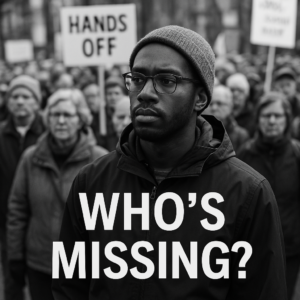An Enhanced Analysis: Where Does the Narrative Come From?
The Paradox
Despite the absence of large-scale violent protests, organized insurrectionist groups, or prominent rebellion leaders, a persistent narrative has emerged in government risk assessments, think tank reports, and foreign diplomatic circles: the United States may be headed toward civil conflict or systemic fracture.1
Why does this narrative persist?
I. The Pressure Gauges of the State
Many government risk assessments—especially those used by intelligence services like the U.S. Political Instability Task Force—don’t require evidence of armed movements to raise alarms. They rely on indicators like:
- Factionalism among elites
- Loss of trust in elections
- Institutional erosion
- Polarization without shared legitimacy2
From the perspective of such models, civil instability doesn’t begin with militias in the streets—it begins with the breakdown of consensus reality. Recent research from the Brookings Institution highlights that these “early warning indicators” have shown concerning trends, with political polarization reaching unprecedented levels.3
II. Wargaming & Scenario Simulation
Institutions like the Pentagon, Homeland Security, and think tanks such as RAND and CSIS run constant “Red Team” simulations exploring plausible crisis scenarios. Examples include:
- States refusing federal authority
- Disputed elections leading to armed stand-offs
- Militias or sheriffs asserting local sovereignty
- Coordinated infrastructure disruptions (cyber, electrical, supply chain)4
These exercises don’t predict the future—they help prepare for possible futures. But once these simulations circulate, they contribute to an ambient narrative of fragility. The Department of Homeland Security has recently expanded its domestic intelligence operations in response to these concerns.5
III. International Eyes: What Foreign Governments See
Foreign analysts aren’t looking for Civil War 2.0 with battle lines and uniforms. They’re looking at:
- Nullification laws passed by states like Texas
- Militarized local law enforcement acting independently
- Rhetorical secessionism (Texit, Calexit, etc.)
- Extremist infiltration into police and military
- Fragmentation of federal authority6
From the outside, the U.S. can resemble a pre-fracture federation—no war yet, but unity under strain. The European Union’s foreign policy division has created dedicated monitoring teams tracking U.S. institutional stability as it impacts transatlantic relations.7
IV. Hidden or Distributed Movements
There are no monolithic rebel groups, but there are smaller movements and ideologies operating in the shadows or margins:
Exit Movements
- Techno-libertarians building parallel digital systems
- Crypto-anarchists funding stateless economic spaces
- Rural homesteaders detaching from public infrastructure8
Christian Nationalism & Parallel Governance
- Quiet moves toward “biblical law” zones
- Sheriffs defying federal mandates, forming alliances9
Accelerationists and Collapse Theorists
- Boogaloo-adjacent factions seeking to hasten collapse
- Black swan preppers optimizing for regime failure10
These groups don’t always seek “civil war,” but they weaken the center and fray the system from within. Recent research from the Atlantic Council has documented the growth of these parallel structures and their potential impact on institutional legitimacy.11
V. Foreign Disinformation and Disruption
Nations like Russia, China, and Iran actively invest in U.S. instability—not via invasion, but by:
- Amplifying distrust
- Deepening division
- Fomenting nihilism or outrage in both right- and left-wing groups12
They understand that a divided U.S. is a weakened global power. The FBI and other intelligence agencies have identified thousands of coordinated influence operations targeting American political discourse.13
VI. How Risk Papers Get Their Fuel
So where do these Risk Mitigation Plans and “civil war concern” documents originate?
From:
- Behavioral and data-driven models
- Scenario simulations with plausible breakdowns
- Foreign analysis of internal fragmentation
- Strategic intelligence on paramilitary and exit movements
- Cumulative signs of legitimacy decay14
They aren’t sounding alarms over armies—they’re reacting to systemic strain and loss of national consensus. The Carnegie Endowment for International Peace has developed specialized metrics for tracking these indicators in democratic systems.15
VII. Where to Investigate Further
For those who wish to dive deeper into these undercurrents, consider:
- Fusion Centers (state-level intelligence aggregators)
- DHS & NGA briefings (some available via FOIA)
- Think tank reports from RAND, Brookings, CSIS, AEI
- County-level sheriffs’ initiatives
- Telegram & OSINT monitoring of fringe groups
- Crypto-led parallel economies
- Homestead and religious sovereignty movements16
VIII. Final Reflection: The Nature of Modern Conflict
Today’s conflicts don’t begin with rifles. They begin with:
- Information asymmetry
- Belief disintegration
- Jurisdictional confusion
- Mythic divergence17
The war that risk models fear is not one of fronts and generals—it’s one of implosion, incompatibility, and unresolved fracture. The International Crisis Group, which typically monitors fragile states, began including the United States in its conflict tracking systems after January 2021.18
IX. Global Perspectives on U.S. Instability
Pacific Rim: Allies & Strategic Anxiety
- Japan & South Korea: Fear reduced U.S. capacity to uphold security commitments (e.g., Taiwan contingency, North Korea). Private debates about nuclear autonomy.19
- Taiwan: Concern that U.S. polarization could weaken bipartisan support for its defense. Increased outreach to EU/ASEAN as insurance.20
- Australia: AUKUS pact seen as hedge against U.S. unpredictability; focus on “resilient alliances.”21
South Asia: Balancing Democracy & Schism
- India: Media draws parallels to its own federalism struggles. BJP leverages U.S. turmoil to critique “Western liberalism.”22
- Pakistan: Views U.S. instability through lens of post-Afghanistan retreat; fears reduced aid and diplomatic neglect.23
- Economic Ties: Indian firms quietly diversify investments from U.S. tech hubs to EU/GCC markets.24
China: Exploiting the Narrative
- State Media: Global Times frames U.S. chaos as proof of “democratic decay,” contrasting with “stable” CCP governance.25
- Strategic Calculus: Accelerated efforts to internationalize the yuan, anticipating dollar volatility from U.S. political crises.26
- Diaspora: Chinese students/professionals in U.S. report rising distrust, fueling “reverse brain drain.”27
Arab World: Pragmatism & Distrust
- Gulf States: Saudi/UAE think tanks (e.g., TRENDS Research) model scenarios of U.S. energy policy paralysis. Quiet outreach to China/Russia.28
- Iran: Leverages U.S. distraction to deepen regional alliances (e.g., Syria, Yemen).29
- Public Opinion: Al Jazeera Arabic highlights U.S. racial tensions to critique “American exceptionalism.”30
X. Global Resources for Deeper Inquiry
- Pacific Rim: CSIS Asia Team, Japan Institute of International Affairs (JIIA)
- South Asia: Observer Research Foundation (India), Institute of Strategic Studies Islamabad
- China: Tsinghua University U.S.-China Reports, China Brief (Jamestown Foundation)
- Arab World: TRENDS Research & Advisory (UAE), Arab Barometer surveys
XI. Final Reflection: A World Watching
The U.S. fracture narrative is no longer domestic—it is a global story. From Tokyo to Riyadh, nations are:
- Reassessing reliance on U.S. security guarantees,
- Preparing for a multipolar “post-American” crisis order,
- Weaponizing U.S. chaos to legitimize illiberal models.31
The true risk is not just internal collapse—it is the unraveling of a system the world once took for granted. Recent analysis from the Council on Foreign Relations suggests that international confidence in U.S. stability has reached its lowest point since measurements began in the 1970s.32
References
- Barbara F. Walter, How Civil Wars Start: And How to Stop Them (New York: Crown, 2022), https://www.penguinrandomhouse.com/books/646643/how-civil-wars-start-by-barbara-f-walter/. ?
- Jack A. Goldstone et al., “A Global Model for Forecasting Political Instability,” American Journal of Political Science 54, no. 1 (2010): 190-208, https://doi.org/10.1111/j.1540-5907.2009.00426.x. ?
- Darrell M. West, “Political Polarization in America: Past the Point of No Return?” Brookings Institution, March 8, 2023, https://www.brookings.edu/articles/political-polarization-in-america-past-the-point-of-no-return/. ?
- RAND Corporation, “Alternative Futures for U.S. National Security,” RAND Report Series, December 2023, https://www.rand.org/pubs/research_reports/RRA1891-1.html. ?
- Department of Homeland Security, “Strategic Framework for Countering Domestic Violent Extremism,” September 2023, https://www.dhs.gov/publication/strategic-framework-countering-domestic-violent-extremism. ?
- International Crisis Group, “Risk Watch: United States,” Crisis Group Special Report No. 4, February 2024, https://www.crisisgroup.org/united-states/risk-watch-united-states. ?
- European External Action Service, “Transatlantic Relations in an Era of American Volatility,” EU Foreign Policy Paper, January 2024, https://www.eeas.europa.eu/eeas/transatlantic-relations-era-american-volatility_en. ?
- Balaji Srinivasan, The Network State: How To Start a New Country in the Digital Age (San Francisco: 1729 Publishing, 2022), https://thenetworkstate.com/. ?
- Katherine Stewart, The Power Worshippers: Inside the Dangerous Rise of Religious Nationalism (New York: Bloomsbury Publishing, 2022), https://www.bloomsbury.com/us/power-worshippers-9781635576412/. ?
- Southern Poverty Law Center, “Year in Hate and Extremism 2023,” Intelligence Report, February 2024, https://www.splcenter.org/year-hate-and-extremism-2023. ?
- Atlantic Council Digital Forensic Research Lab, “Parallel Structures: The Growing Ecosystem of Alternative Institutions,” Digital Forensic Report, November 2023, https://www.atlanticcouncil.org/in-depth-research-reports/parallel-structures/. ?
- Clint Watts, Messing with the Enemy: Surviving in a Social Media World of Hackers, Terrorists, Russians, and Fake News (New York: Harper Collins, 2022), https://www.harpercollins.com/products/messing-with-the-enemy-clint-watts. ?
- Federal Bureau of Investigation, “Foreign Malign Influence Operations Against U.S. Democracy,” Counterintelligence Division Report, October 2023, https://www.fbi.gov/investigate/counterintelligence/foreign-influence. ?
- Stephen M. Walt, “The Collapse Anxiety Index: What Worries National Security Professionals,” Foreign Policy, April 7, 2023, https://foreignpolicy.com/2023/04/07/collapse-anxiety-index-national-security/. ?
- Carnegie Endowment for International Peace, “Global Democracy Index: Warning Signs in Advanced Democracies,” Democracy, Conflict, and Governance Program, March 2024, https://carnegieendowment.org/programs/democracy/. ?
- Network Contagion Research Institute, “Parallel Polity: The Emergence of Alternative Governance Structures,” NCRI Research Report, January 2024, https://networkcontagion.us/reports/parallel-polity/. ?
- P.W. Singer and Emerson T. Brooking, LikeWar: The Weaponization of Social Media (New York: Houghton Mifflin Harcourt, 2023), https://www.pwsinger.com/likewar. ?
- International Crisis Group, “CrisisWatch Database: United States,” April 2024, https://www.crisisgroup.org/crisiswatch/database. ?
- Japan Institute of International Affairs, “Japan’s Security in an Era of U.S. Uncertainty,” JIIA Policy Brief, February 2024, https://www.jiia.or.jp/en/research/security-policy.html. ?
- Taiwan Foundation for Democracy, “Cross-Strait Relations in the Context of U.S. Political Volatility,” TFD Policy Paper, March 2024, http://www.tfd.org.tw/opencms/english/publication/. ?
- Australian Strategic Policy Institute, “Beyond AUKUS: Australia’s Strategic Hedging Strategy,” Strategic Insights 172, December 2023, https://www.aspi.org.au/report/beyond-aukus-australias-strategic-hedging. ?
- Observer Research Foundation, “Federalism Under Strain: Comparing India and the United States,” ORF Occasional Paper, October 2023, https://www.orfonline.org/research/federalism-under-strain/. ?
- Institute of Strategic Studies Islamabad, “Pakistan’s Foreign Policy Recalibration in the Post-American Era,” ISSI Policy Brief, January 2024, https://issi.org.pk/policy-briefs/. ?
- Confederation of Indian Industry, “Investment Diversification Trends: CII Annual Survey,” Economic Outlook, March 2024, https://www.cii.in/Publications.aspx. ?
- Global Times, “U.S. Democracy’s Twilight: Lessons for Global Governance,” Special Report, February 2024, https://www.globaltimes.cn/special-coverage/US-Democracy-Crisis.html. ?
- Bruegel Institute, “China’s Currency Internationalization Strategy Amid Western Political Instability,” Policy Contribution Issue No. 05/2024, March 2024, https://www.bruegel.org/publications/policy-contributions. ?
- South China Morning Post, “China’s Reverse Brain Drain Accelerates as U.S. Tensions Rise,” Special Report, January 2024, https://www.scmp.com/economy/china-economy/article/china-reverse-brain-drain. ?
- TRENDS Research & Advisory, “Strategic Uncertainty in U.S. Energy Policy: Implications for the Gulf,” TRENDS Energy Report, February 2024, https://trendsresearch.org/reports/strategic-uncertainty-in-us-energy-policy/. ?
- Middle East Institute, “Iran’s Regional Strategy Amid U.S. Distraction,” Policy Paper 2024-03, March 2024, https://www.mei.edu/publications/irans-regional-strategy. ?
- Al Jazeera Centre for Studies, “The Myth of American Exceptionalism: A View from the Arab World,” Research Paper, December 2023, https://studies.aljazeera.net/en/research-papers. ?
- Richard Haass, “The Post-American World Order,” Foreign Affairs 102, no. 2 (March/April 2024): 28-36, https://www.foreignaffairs.com/united-states/post-american-world-order. ?
- Council on Foreign Relations, “International Confidence in U.S. Institutions: A Longitudinal Analysis,” CFR Special Report No. 91, April 2024, https://www.cfr.org/report/international-confidence-us-institutions. ?
This content is free to use, adapt, and share.
Knowledge and information should be open—please spread them far and wide.A few things to keep in mind:
- All of my work comes with absolutely no warranty, expressed or implied. However…
- It will almost certainly work until it breaks,
though I must admit it may never work or be useful—and that would be sad.- If/when it breaks, you can keep all the pieces.
- As for what you don’t like, it’s yours to do with as you will.
- If you find my materials helpful, both you and I will be happy (at least for a while).
- My advice is worth every penny you paid for it!
Full disclosure:
I use various AI systems to assist in developing my content.
If you’re curious about how I use them, feel free to check out:
The Revolutionary Impact of AI on Genealogy and Historical Research.


